I’ve always wanted to play with a thermal imaging camera, they open up a whole different hidden world at the far end of the infra-red spectrum so last week I finally got a chance to do that and take some photos.
With winter on the way I needed to find out where my house was insulated and where it wasn’t. Since it’s an old house with quite a few previous owners I had no idea what had been insulated or what had not been insulated. I ended up renting a FLIR (Forward Looking InfraRed) camera from Ajax Environmental in Texas. They ship priority and you have to ship it back priority so expect to spend a lot on shipping. It wasn’t a cheap rental but it provided me with a lot of good and somewhat depressing information about my old house. I’ve heard that some fire departments or county/town energy departments will loan thermal cameras in some circumstances so this may be worth checking into before spending any money.
While I took a lot of pictures of the house I’m going to put those on my House Blog later this weekend. While I had the camera I took a lot of photos of random things around the house, so I’ll just get to the meat here and show you the photos with descriptions. There are quite a few photos here and I hope you enjoy them. The images from this camera are pretty small, so clicking on them might make them a little bigger, but not much.
Above: Self Powered USB Hub. You can see the heat from the voltage regulator on the left hand side. The white areas are 108 degrees, with the darker cooler blues being around 74. The stick in one of the ports is my wireless headphone adapter which seems to generate a bit of heat itself.
Above: These are the raid drives in my computer. While they look hot, the thermal image is relative. White can mean 100 degrees or 300 degrees, depending on what’s in the image. In this case the hottest point is 116 degrees on the bottom hard drive with the top hard drive being a bit cooler. This is no surprise as the top hard drive is directly behind the front case fan. With the plastic clips this case uses to hold hard drives, there’s not very good thermal transfer to the hard drive bracket itself to dissipate heat.
Above: This is my computer’s motherboard. It’s an ASUS motherboard with an i7 quad core processor and triple channel memory. White is representing about 149 degrees. You can see three chips on the board which are pretty warm. The white spot on the bottom right is the BIOS chip. The curved piece you see is a metal heat pipe. In most cases metal acts as a mirror to infrared energy and reflects it’s surrounding. Even unpolished metal will reflect heat like a mirror. It’s pretty amazing. The three cooler piece at the top are the memory modules.
Above: This is the stock Intel cooler for my quad core i7 processor. The metal of the heatsink will reflect what’s in front of it, but it does run pretty cool. This is running with a moderate load. You can see a spot of heat in the center of the fan which is probably from the driver electronics. All of the fans in the case had this hot warm center point.
Above: Here’s a thermographic photo of 3 of our Dell servers at the office. The bottom one has 5 drives the middle one has 2 and the top one only has one. You can see the grill pattern inside of the case on top. These are front air intake, rear exhaust rack mount cases so you can see the hard drives on the left side of the case maintain quite a bit of heat. The power supply sits behind these drives and blocks airflow a little bit more than the rest of the hard drives.
Above: Back to my home computer you can see the heat emitted from the main CPU voltage regulator at about the middle of the picture. Above the circular fin arrangement of the CPU cooler you can see the thermal outline of the heatsink for the voltage regulator FETs.
Above: You can see a couple of voltage regulators in this photo as well. They sit in between a couple of the PCI Express slots. The dark colored dots on the board are the capacitors, fortunately they’re all running cool so nothing failing there thermally anyways.
Above: Here’s a better shot of the DIMMs on my motherboard. It’s a triple channel setup and you can barely make out the top of the fins which look like little squares. The memory modules have aluminum heatsinks which will reflect their environment, which in this case is cooler. If you shoot at an off angle you can reduce this reflection a large amount.
Above: A wide shot of the side of my computer case. You can see the little warm spots on each of the fans, and the white paint that says “Raid Max // Dirk-Tooth” emits thermal radiation, and the reflection of the surrounding metal and shows a cool blue. The rest of the metal is anodized black which seems to cut the reflection quite a bit as well.
Above: This is the thermal image looking at the front of my case. The top bay houses my DVD/RW drive and you can see some heat build up there. White is representing 95 degrees in this photo. Below that drive you can see the drive bay blanks, and you can actually tell where the thickness of the material varies.
Above: This is the side of the case with the cover back on. You can see cooler spots at the right side of the acrylic, the blue line is a large vent and then you can see where the air is drawn through the case. The two holes on the left are intake and exhaust fans.
Above: This is my entertainment center. The box at the top is the cable TV box. On the right side middle is the Nintendo Wii and on the bottom is a wall wart power adapeter. On the left side top is the Cable modem, and below that is a power strip with a wall wart power transformer plugged into it. Barely visible below the cable box is a stereo tuner.
Above: This is the engine compartment of a Honda Accord just after being run. As you can see the temps in here are pretty high. You can make out the ignition wiring at the bottom and some cables at the top of the photo.
Above: Here’s a thermal photo of a recently used disc brake. I took pictures of both sides of the vehicle to see if one side was hotter than the other, possibly indicating that one brake caliper was working harder/hotter than the other, but they both measured out about the same.
Above: And here’s a photo of a drum style brake. You can see the reflections of my legs in the metal trim around the outside of the rim. The drum is the bright colored spot, and it’s quite a bit cooler than the front rotors. I might pull these off to make sure the adjusters are working and the pads are good, but drums just might run cooler since they have more thermal mass to them.
Above: This is a particularly interesting photo of my trucks engine compartment. You can see the heat abruptly cuts off at the front panel where it meets the door. you can see the heat from a tree reflecting off the windshield of the truck and also off of the hood of the truck.
Above: Here’s a close-up shot of an exhaust manifold on a 4-cylinder engine. The thermal camera measures the temperature at the hot spots as high as 302 degrees or higher. I’m not sure if 302 degrees is the limit of the sensor as exhaust manifolds can get extremely hot. You can also make out the spark plug wires on the left and right hand side.
Above: Moving into the house now. This is a wall wart power transformer used to charge the car jump-box seen on the right. You can see the wall box has picked up a little heat, but there’s some cold air coming in under the door.
Above: Thermal image of a Keurig K-Cup coffee maker shortly after use. These coffee makers are great, and they make tea and cocoa and other things too. I’d love to get one for the house as I usually don’t wake up early enough to wait for a whole pot to brew (and wouldn’t drink a whole pot anyways).
Above: These are the ends of fluorescent light tubes. While both tubes are dark in the fixture the tube on the right has a thermal signature from the working filament. The filament in the tube on the left is burned out and therefore the fixture isn’t igniting. At the other end of the tubes both filaments are lit. Once I could see which filament was shot I tapped on the tube which knocked the filament pieces into contact with each other long enough to ignite the lamp and had a working fixture the rest of the day.
Above: Here’s another shot of the thermal radiation from a non-lit fluorescent tube with a working filament. You can see the letting ‘H.O.’ (high output) printed on the tube just above the the black box because it actually is hotter than the glass envelope itself.
Above: This is cold water coming out of my kitchen sink as seen by the thermal camera. The picture below shows hot.
Above: Once the water heated up I took another photo. It’s amazing how the water becomes dynamic. If you ever get access to a thermal camera I highly suggest checking this out. It’s a very nice fade effect.
Above: I mentioned that metal acts as a reflector for thermal energy. Glass does as well within a certain angle. If you’re shooting dead on like I did in this photo it makes a great reflector. You can see me reflected in this narrow window holding the infrared camera and behind me the cooler back part of the house showing in deep blue. Make a not that this is only a 10 degree F temperature difference from white(hot) to deep blue(cold).
Above: This photo was taken at a friends house. This cool wall surrounds an unused chimney. I put my hand against the wall for just a few seconds and was then able to take a thermographic photo of the hand print. The prints actually will stay visible for a fair amount of time. You can also see footprints on cool floors and carpets.
Above: This is a thermal picture of one of the LED displays I work with at work. The display is about 3 foot tall by 5 foot wide. You can see how the heat builds up on the actuall LED panels themselves from the LEDs running. At the bottom center of the cabinet is air intake fan which provides cooling and on the sides are power supply boards which generate a bit of heat and add to the warmth in the cabinet.
That’s all of the non-insulation/house photos I took with this FLIR B50 Thermal Imaging camera that turned out well. I hope you enjoyed looking through them. I’m sure I wasn’t able to take full advantage of this camera as there’s quite a few different options. I might have needed another week or so of playing with it to get everything down really good. The manual was good and informative though. If you have any questions about how/why I shot things or what not feel free to provide your input below.

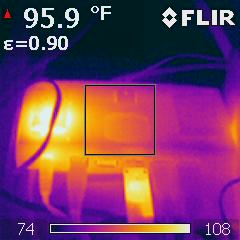
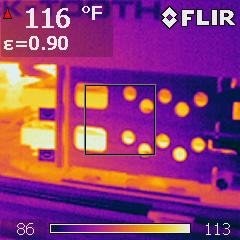
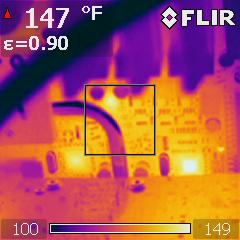
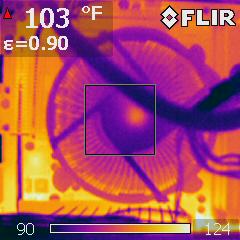
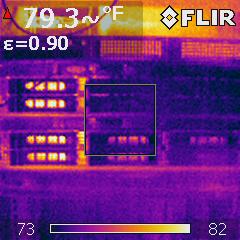
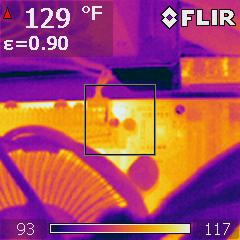
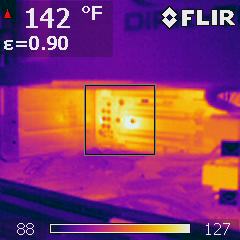
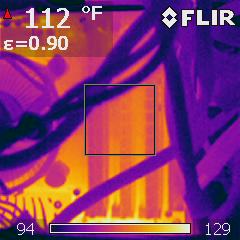
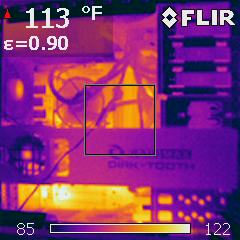
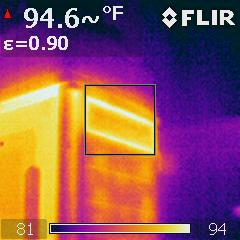
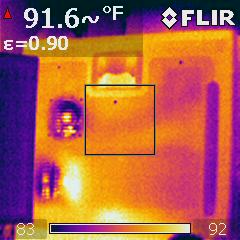
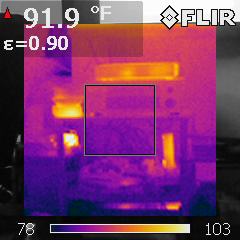
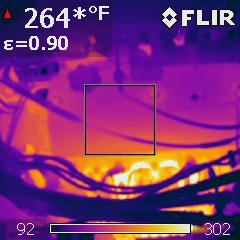
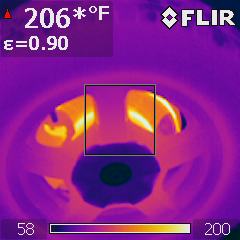
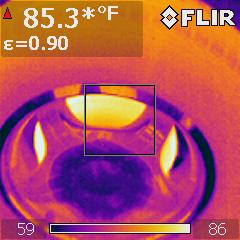
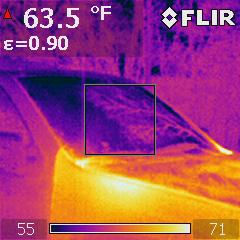
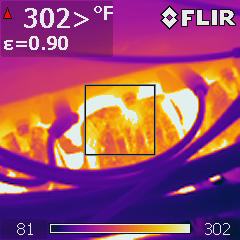
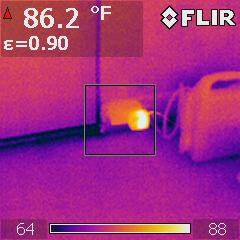
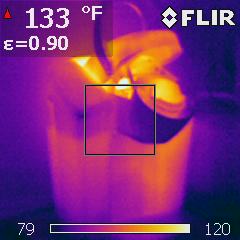
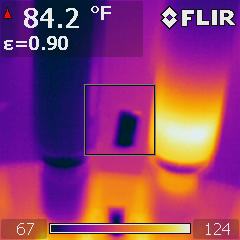
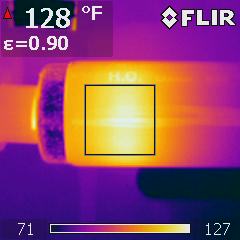
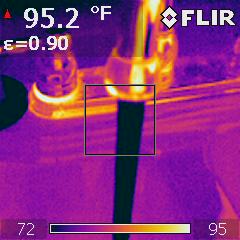
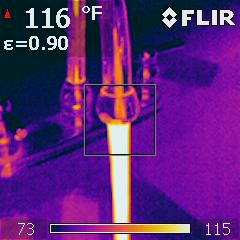
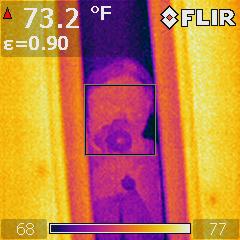
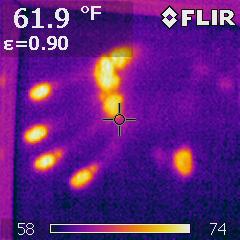
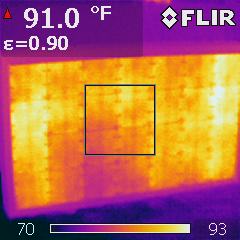
1 responses to Fun with a FLIR Thermal Imaging Camera
Jon,
What an amazingly great idea! My 80 year old house could use this, but as you say it may be more depressing and expensive to find out.
Mark
Leave a reply to Fun with a FLIR Thermal Imaging Camera